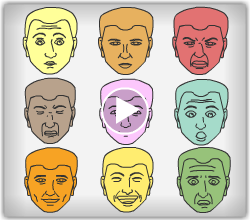NIFT EXAM SYLLABUS
NIFT B.Des Entrance Syllabus
For B.Des programme, NIFT holds entrance exam in two phases. In order to get admission, as a NIFT aspirant you need to appear and clear both the examinations.
- First Phase examination comprising of Creative Ability Test (CAT) and General Ability Test (GAT). The first phase exams are generally held in the month of Feburary every year.
- Second Phase: Shortlisted Candidates from the first phase appear for Situation Test. This test comprises of 3D model making using the materials provided in the exams. Previous Year Questions for NIFT Situation Test.
NIFT B.Des Cat Syllabus
Creative Ability Test (CAT): For NIFT CAT exam, candidates are evaluated on the basis of the following aspects
| Intuitive Ability | Creative Ability |
| Drawing Skills | Innovative use of colours |
| Observation Power | Concept Development |
| Ability to Design | Illustration Skills |
NIFT B.Des Gat Syllabus
Components of the General Ability Test
| Sub-Test | Topics | |
| 1 | Quantitative Ability | Addition, Multiplication, Division, Fractions, Percentage, Rate of Interest, Work & Task, Ratio & Proportion and Distance. |
| Tests the quantitative ability of the candidates. | ||
| 2 | Communication Ability & English Comprehension |
Synonyms, Antonyms, Words with corresponding meanings, Singular, Plural, One word substitutes, Idioms & phrases, Correct spellings, Comprehend a situation from a given passage etc.
|
| Tests the language ability of the candidates in day to day communication in English. | ||
| 3 | Analytical Ability and Logical Ability | Series Test, Analogy Test, Classification Test, Blood Relation Test, Coding Decoding Test, Direction Sense Test, Venn Diagram Test etc. |
|
Tests the candidate's capacity for inference & logic from the given information. To evaluate the candidate's ability to identify the given problem and apply reasoning in solving the core issues of the problem. |
||
| 4 | General Knowledge & Current Affairs | |
| Tests the candidate's general knowledge & current affairs. |
NIFT B.Des Situation Test Syllabus
Shortlisted Candidates for B.Des from the written entrance examination are required to undergo a Situation Test which is a hands-on test to evaluate the candidate's skills for material handling & innovative ability on a given situation with a given set of materials. Candidates will be asked to make a model. The model will be evaluated on space visualization, innovative & creative use of given material, composition of elements, colour scheme, construction skill, finese of the model and overall presentation etc. These parameters will be checked with the write up explaining the concept behind the model constructed.
More to Explore...

NIFT Study Material
NIFT Books: Available in Full, Mini, Combo & Test Series Pack. Doorstep delivery across India.
Details
NIFT eBooks
Study at Home with NIFT eBooks! Instant Download Material. Saves Time. Learn at your own pace!
Details
NIFT Video Packs
NIFT Video Packs: Engaging Video Lessons supported by E-Books. Instant Downloadable.
Details
NIFT Downloads
Download NIFT Previous Year Papers. One Click Free Downloads. No Form Filling Required
DetailsNIFT M.Des Entrance Syllabus
For M.Des programme, NIFT holds entrance exam in two phases. In order to get admission, as a NIFT aspirant you need to appear and clear both the examinations.
- First Phase examination comprises of Creative Ability Test (CAT) and General Ability Test (GAT). The first phase exams are generally held in the month of Feburary every year.
- Second Phase: Shortlisted Candidates from the first phase appear for Personal Interview (PI).
NIFT M.Des Cat Syllabus
Creative Ability Test (CAT): For NIFT CAT exam, candidates are evaluated on the basis of the following aspects
| Intuitive Ability | Creative Ability |
| Drawing Skills | Innovative use of colours |
| Observation Power | Concept Development |
| Ability to Design | Illustration Skills |
NIFT M.Des Gat Syllabus
Components of the General Ability Test (For all Programmes)
- Quantitative Ability: This sub-test is designed to test the quantitative ability of the candidates. The sub test consists of questions on Addition, Multiplication, Division, Fractions, Percentage, Rate of Interest, Work & Task, Ratio & Proportion and Distance.
- Communication Ability & English Comprehension: This sub-test is aimed at testing the language ability of the candidates in day to day communication in English. It includes questions on synonyms, antonyms, words with corresponding meanings, singular, plural, one word substitutes, idioms & phrases, correct spellings, comprehend a situation from a given passage.
- Analytical Ability and Logical Ability: This sub-test is designed to test the candidate's capacity for inference & logic from the given information and to evaluate the candidate's ability to identify the given problem and apply reasoning in solving the core issues of the problem. Concepts and practice of creative and lateral thinking are likely to be useful.
- General Knowledge & Current Affairs: This sub-test is designed to test the candidate's general knowledge & current affairs.
NIFT M.Des PERSONAL INTERVIEW (PI) SYLLABUS
A candidate is judged on the various parameters during individual personal interview by a panel, as listed below:
- Career Orientation
- Aptness for the course
- Overall personal achievements in academics & co-curricular activities
- Communication
- General Awareness & Aptitude, creative & lateral thinking are likely to be useful
Written exam structure for all UG and PG design Programmes
General Ability Test (GAT)
| PROGRAMMES | BDes | MDes |
| Paper Name | GAT | GAT |
| Language of Written Test | English/Hindi | English/Hindi |
| Test Duration (MIN) | 120 | 120 |
| Sections | Number of Questions | Number of Questions |
| Quantitative Ability | 20 | 20 |
| Communication Ability | 40 |
30 |
| English Comprehension | 30 | |
| Analytical & Logical Ability | 15 | 25 |
| General Knowledge and Current Affairs | 25 | 15 |
| Total | 100 | 120 |
The number of questions may vary in each section and for each course year to year. The level of difficulty in questions for courses may vary.
For latest NIFT updates please visit the website http://www.nift.ac.in
About the Author: Anu Handa is an Interior Designer, DIY Artist, Co-Founder and Educator at Mosaic Institute of Design. She has been the lead blogpost writer at www.mosaicdesigns.in since 2009. Her educational background in Interior Design, Urban Planning and the English Language has given her a broad base to cover a range of topics in her articles. Anu has spent 15+ years training Design & B.Arch Aspirants for entrance exams.
Passionate about Design Education, she’s briefly worked with Annamalai University as a paper setter for Design Exams. Likes to write about Design, Architecture and related fields, on online platforms like Quora. Aims at challenging the conventional & age old teaching methodology.





















